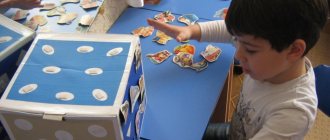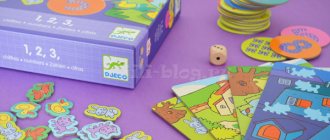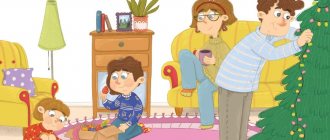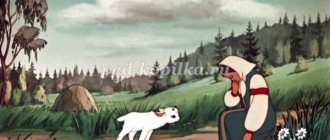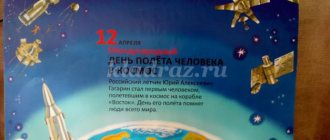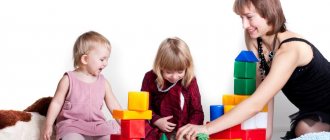Didactic board-printed adventure game “Human Dwelling”
Didactic board and printed game - adventure game
"Human Dwelling"
Explanatory note
Name of the game:
"Human Dwelling"
Relevance.
Games are an effective means of strengthening children’s skills and abilities. It is in play that a child acts freely and often what is difficult for him becomes accessible and understandable. The game provides development and familiarization in various areas, for example, the area of cognition, speech development.
Adventure games exist not only for leisure time. They also develop fine motor skills, coordination, concentration and social skills. The child, by throwing the dice and counting the moves, strengthens the skills of ordinal and quantitative counting. Masters the relationship between the number (dots on the die) and the number of moves.
Question from children on an excursion to the mini-museum “Human Dwelling”: “What are houses like among different peoples of the world? What are they made of?” contributed to the creation of this game.
Audience:
The game is addressed to speech therapists, educators, tutors, parents and is intended for working with children 6-8 years old. The game can be used at frontal, subgroup events, in individual work with children and in the independent activities of older preschoolers.
The game can be used both to study new material and to generalize, systematize and evaluate children’s knowledge.
Game usage varies from 10 to 20 minutes. No more than five people can take part in the game.
Purpose of the game
: consolidation of knowledge about the evolution of human housing.
Game objectives
Correctional – educational
:
- fix spatial relationships on a sheet of paper (right, left, down, up);
- develop graphic dictation skills.
Corrective and developmental
:
- develop attention, memory, thinking, fine motor skills;
- enrich and activate vocabulary.
Correctional and educational
:
— cultivate a culture of play (follow the rules, show honesty, rejoice at success);
- cultivate interest in the world around you.
Expected results:
- spatial relationships will be fixed on a sheet of paper (right, left, down, up);
— graphic dictation skills are developed;
— the level of attention, memory, thinking increases;
— fine motor skills develop;
- vocabulary is enriched and activated;
— a culture of play is fostered (follow the rules, be honest, rejoice at success);
- interest in the surrounding world increases.
Materials
that were used to create the game: computer, printer, A4 photo paper, laminating paper, laminator.
Game description
The game is original, made using Internet resources. Printed on A4 photo paper and laminated. The game consists of a playing field, chips, and dice.
Rules for using the game.
The game can be played by 2 to 5 players. The chips are set to “Start”
Players take turns moving the pieces as many steps as the number of points on
the dice
. A player's piece can move past steps occupied by other players' pieces or stop on them.
Instructions for use.
If the player's turn falls on:
— purple trail
, then the player answers the question - “What is the name of the dwelling?”
— green trail
, the player answers the question - “What was the house built from?” The child names the material, for example, made of stone.
— yellow trace
, the player answers the question - “What kind of housing?” The child forms a relative adjective, for example, stone dwelling.
— white trail,
the player takes a step in the direction of the arrow.
In addition, if a player answers a question incorrectly, he moves one step back. If true one step forward. The winner is the one who reaches the finish line first. Let's start playing
. Draw of lots.
Questions for the game:
Purple trace:
What is the name of the dwelling of an ancient person? (cave)
What are the names of the Indian dwellings? (wigwam)
What is the name of the Buryat dwelling? (yurt)
What is the home of a modern person called? (house, cottage, apartment)
What is the name of a villager's home? (hut)
Green trace:
What did ancient people build their homes from?
(adapted natural objects - stones, mammoth bones, hollows of large trees)
What do Indians build their homes from? (from animal skin).
What do Buryats build their homes from? (from felt)
What do modern people build their homes from? (made of wood, brick, concrete)
What do rural residents build their homes from? (made of bricks, logs)
Yellow trace:
If the house is made of stone, then what kind of house? (stone)
If the house is made of logs, then what kind of house? (log)
If the house is made of brick, then what kind of house? (brick)
If the house is made of concrete, what kind of house is it? (concrete)
Thank you for your attention!
Didactic game “Houses of different nationalities”
Expected result: children should have an idea of the peculiarities of building houses in the south, north and central part of Russia, the dependence of the house design on weather conditions, and the living conditions of the people; be able to talk about the features of houses and their purpose.
Goals:
develop memory, imagination, speech; to cultivate a sense of patriotism and involvement in the life of different peoples of Russia.
* * *
The teacher divides the children into subgroups - into “residents” of the central part of Russia, the south and the north. Children are given the task to select pictures depicting houses in which they could live, tell why it is possible to live in such a house (chum, yurt, hut, multi-story building),
how the decoration and furniture in their home differs.
Didactic game “Journey through fairy tales”
Expected result: children should know the content of fairy tales that describe the arrangement of different houses and the features of furniture; be able to guess the name of a fairy tale based on individual episodes, characters, retell passages, and dramatize individual plots.
Goals: to develop memory, imagination, expressiveness of speech and pantomime; to develop creative abilities and interest in fairy tales.
* * *
The teacher invites children to remember fairy tales that describe the house, the materials from which it is made, its purpose, decoration and furniture (“Teremok”, “Cat’s House”, “Three Bears”, “Frost”, “Fox, Hare and Rooster”, “Wintermovie”, “Mitten”, “Three Little Pigs”, etc.)
Based on a separate passage or characterization of the hero, children must guess the fairy tale, find a book with illustrations from those offered, tell and describe the house and furniture mentioned in the fairy tale, and act out a short episode. Children receive prizes for expressiveness, creativity, artistry and correctness of the task.
Reading fairy tales
Expected result: children should be able to express judgments and make simple conclusions about events related to fairy-tale furniture and household items.
Goals: develop attention, imagination, speech; develop the ability to sympathize and empathize.
Source:
[2].
* * *
For reading, discussion and dramatization, you can take fairy tales: “The Little Stool”, “About the Nail”, “The Arrogant Chandelier”.
Sand games “Building a castle”
Expected result: children should have an idea that the features of the appearance of houses, their decoration, and interior decoration have changed over time; know the features of ancient castles described in fairy tales and encyclopedias; be able to use illustrations when building a castle, use additional details to decorate the building, prepare sand for construction, and act out fairy-tale scenes around the building using toys.
Goals: to develop imagination, constructive skills and the ability to navigate the terrain, speech; to develop creativity and the ability to negotiate in group games.
For examples of games with sand, see the book: [17].
Let's build a doll's house
(design lesson)
Expected result: children should know the features of apartment arrangement; be able to use a large cardboard box, matchboxes, thick juice boxes, dairy products, wallpaper, colored paper, pieces of fabric to build a dollhouse with furniture for a doll.
Goals: to develop constructive skills, precision of movements, spatial orientation, imaginative thinking; to form accuracy and purposefulness.
It is better to design in several preparatory stages. On the final day, you can start decorating your home using ready-made crafts. Children must arrange the furniture and explain why it will be comfortable to live this way. in the house, decorate the rooms with curtains on the windows, blankets on the bed and sofa, etc.
Children can demonstrate their ability to build doll houses in construction games with tabletop and floor building materials.
Didactic game “Find your home”
Goals:
1. To develop in children knowledge about their locality, about the place of their home in it, about the variety of buildings available in the locality, to develop in children attentiveness, observation, and the ability to find their home among others;
2. To instill in children an interest in their native locality.
Progress of the game:
Children are offered cards that depict several buildings; they need to find their house and justify their answer. Identify the house on the map of the locality.
Didactic game "Restoration"
Goals:
1. To form in children ideas about buildings, architectural monuments of their native locality, the Republic of Crimea, about their diversity, and architectural attractions.
2. Develop children's visual attention, logical thinking and speech - proof;
3. Cultivate curiosity in preschoolers.
Progress of the game:
Children are offered cards where part of the building is missing and cards with
missing elements, the task is to select the necessary part (or complete it).
Didactic game “What did the architect mess up?”
Goals:
1. To consolidate children’s knowledge about the architectural monuments of the settlement, the Republic of Crimea;
2. Develop children's visual attention, observation, memory;
3. To instill in children an interest in their native locality, the Republic of Crimea.
Progress of the game:
On the proposed cards there is an error in the depiction of buildings; the child’s task is to find it and justify his answer.
Didactic game “Pick up a housewarming gift”
Goals:
1. To form in children ideas about the diversity of cultures and traditions in Crimea.
2. To develop logical thinking in children, the ability to classify objects according to any criteria;
3. Cultivate interest in the traditions of the peoples inhabiting Crimea.
Progress of the game:
Children are asked to place individual cards in the field to which they correspond. For example, in the house of the Crimean Tatars there are those items that are traditionally found in their houses. To check, you can ask the children to turn the cards over; if the cards are the same color, then the task was completed correctly. You can play with a subgroup of children, in this case the driver shows the cards, and the players choose the desired picture.
Didactic game “Seasons in the city”
Goals:
1. To consolidate and clarify children’s ideas about the different seasons of the year;
2. Develop coherent speech when composing descriptive stories about the seasons;
3. Develop observation, visual attention, memory;
4. Cultivate interest in the nature of your hometown.
Progress of the game:
A lotto-type game, the child must pick up cards with a certain season and justify his answer. In the future, when selecting pictures, you can complicate the task by asking them to come up with a story about the time of year.
Didactic game "Door hole".
Goals of the game:
1. to form ideas about architectural monuments in their native locality, the Republic of Crimea, to develop memory, attention, spatial thinking in children of senior preschool age;
2. cultivate love and respect for their native locality, the Republic of Crimea.
Progress of the game:
It is best to play in a group of 4-5 people. The presenter covers the picture with a sheet of paper with a keyhole and places it in front of the players. You can view the picture only through the hole, gradually moving the top sheet, but without lifting it. Everyone looks at it at the same time, but everyone moves the sheet for a minute. Then the presenter suggests that someone tell what is shown in the picture, the others correct and complement it. At the end of the game, the picture opens and the presenter announces the winner who told the story most correctly and in detail. He replaces the leader.
As a complication: first the keyhole is larger, then the size decreases. You can look at photos of natural objects, architectural monuments, etc.
